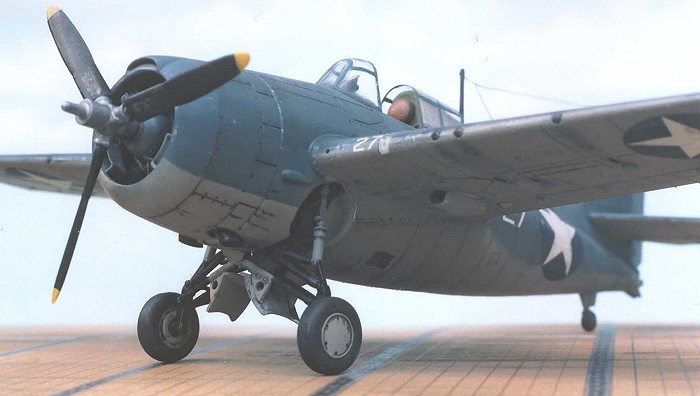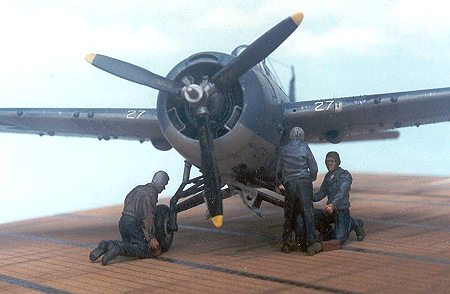
|
KIT # |
61034 |
|
PRICE: |
£17 |
|
DECALS: |
See Review |
|
REVIEW: |
Andrew Johnson |
|
NOTES: |
Aires Cockpit set/Aeromaster decals used |

|
HISTORY |
There were some grumbles about the F4F-4 being heavier and less maneuverable than the F4F-3 which performed so well at the Battle of the Coral Sea. Additional machine guns and ammunition would certainly reduce the rate of roll. Four 0.50s’ were more than enough to destroy a Japanese aircraft, but six meant more lead in the air, and improved the chances of a novice hitting something. But thanks to a demand of the Royal Navy, who had been operating the F4F as the ‘Martlet’ the F4F-F had one enormous advantage over its predecessor, folding wings. A US carrier could now go to sea with a far larger fighter group than before. In some ways the F4F had many inferiorities compared to its main adversary, the Japanese Zero, particularly in the classic dog fighting characteristics of turn and climb. However, with armour plate, self-sealing fuel tank and a strong construction the F4F would frequently bring the pilot back to fight another day. The Guadalcanal ace, Joe Foss, said in combat with Zeros it was often not a case of if you would get hit, but when. The F4F pilots overcame the inferiorities of their aircraft through intelligent tactics and teamwork.
 At the battle of Santa
Cruz, the USN risked their last two serviceable carriers, Enterprise and Hornet
to protect the Guadalcanal landings. For the last time in the Pacific war the
Japanese enjoyed carrier superiority, with Junyo, Shokaku, Zuikaku and Zuiho
available and the potential for a crushing victory to avenge Midway was on the
cards. Following detection from scouting aircraft the opposing forces launched
their attacks at practically the same moment on 26th October 1942.
The Americans had the advantage of enormously upgraded anti-aircraft gun power
on their ships plus radar warning and fighter direction.
At the battle of Santa
Cruz, the USN risked their last two serviceable carriers, Enterprise and Hornet
to protect the Guadalcanal landings. For the last time in the Pacific war the
Japanese enjoyed carrier superiority, with Junyo, Shokaku, Zuikaku and Zuiho
available and the potential for a crushing victory to avenge Midway was on the
cards. Following detection from scouting aircraft the opposing forces launched
their attacks at practically the same moment on 26th October 1942.
The Americans had the advantage of enormously upgraded anti-aircraft gun power
on their ships plus radar warning and fighter direction.
The events of 26th October showed that radar controlled fighter direction still had not reached the efficiency that would dominate the scene in 1944, and when the Japanese attack waves struck many of the CAP were in the wrong position to intercept. Only 8 Wildcats from VF72 were in an immediate position to confront the first Japanese attack wave at 12,000’ at 09:00, Ens George Wrenn in no 27 was unable to reach a firing position on one of the Val’s before being forced to dive to evade the escorting Zeros. Recovering at low altitude he found himself behind six torpedo laden Kate’s from Shokaku on their final approach to Hornet. His fire caused one aircraft to smoke and abandon its run, whilst a second was set on fire and finished off by AA from the Juneau.
Wrenn then had to pull away himself to avoid the ‘friendly' AA fire. The Hornet was not hit by torpedoes during this attack, but had been hit 3 times by the Val dive-bombers. One group of Kate torpedo bombers from Shokaku led by LCdr Murata escaped from the CAP and managed to hit hornet with two torpedoes at 09:17, but Murata did not escape the Task Force AA fire. The torpedo hits were eventually to prove fatal to the carrier. With dwindling fuel, Ens. Wrenn put down on the Enterprise during the battle, and had to stay in the cockpit standing on the wheel brakes as the carrier twisted and turned.
Both sides called off the action, the Americans had lost the Hornet, the Japanese had lost most of their irreplaceable dive-bomber and torpedo bomber experts to the task force AA and Wildcat combination.
|
CONSTRUCTION |
 The Tamiya kit means of
course an excellent quality product. Like me you may want to improve on it a
little. The PW R-1830 could do with some push rods for a start, so simply add 20
thou plastic rod. Then 5-amp fuse wire for the two ignition leads per cylinder,
and 10-amp fuse wire for the oil leads emanating from the propeller reduction
gear casing (see Walk around guide). I painted the lower part of the cylinders
Humbrol metal, and the upper head Humbrol silver, and all were finished with an
oil wash. The two-tone paint job on the cylinders reflects the different
machining of the fins on the upper and lower part of each cylinder. Between the
engine and the bulkhead is the space for the landing gear. Because there is so
much space in there, and you can see the back of the engine, I added extra pipe
work with fuse wire, following the ‘Walk around’ guide to make it more busy.
I wonder if any other WWII aircraft had their undercarriage retracted by the
pilot working a crank?
The Tamiya kit means of
course an excellent quality product. Like me you may want to improve on it a
little. The PW R-1830 could do with some push rods for a start, so simply add 20
thou plastic rod. Then 5-amp fuse wire for the two ignition leads per cylinder,
and 10-amp fuse wire for the oil leads emanating from the propeller reduction
gear casing (see Walk around guide). I painted the lower part of the cylinders
Humbrol metal, and the upper head Humbrol silver, and all were finished with an
oil wash. The two-tone paint job on the cylinders reflects the different
machining of the fins on the upper and lower part of each cylinder. Between the
engine and the bulkhead is the space for the landing gear. Because there is so
much space in there, and you can see the back of the engine, I added extra pipe
work with fuse wire, following the ‘Walk around’ guide to make it more busy.
I wonder if any other WWII aircraft had their undercarriage retracted by the
pilot working a crank?
I used the Aires cockpit insert to add extra detail to the interior. The insert is far from an easy fit inside the concave tub of the wildcat and you really have to peer deep inside to see the difference. It does of course have the gaps either side of the pilot’s legs so that he could see through the small windows on the planes belly. You realize when installing the set that the pilot sat over his fuel tank. For the canopy, I cut off the windshield from the kit, but used the Squadron Signal vac form for the sliding hood.
|
PAINT & DECALS |
 To add interest to the
finish I began by under shading the model along panel lines (not too heavily
along the spine) and also under-lightening by spraying white on some of the
upper surfaces to imply faded paint. The blue and underside grey came from the
Aeromaster range. Following varnishing, Micro Sol was essential to get the
decals from the Aeromaster range to snuggle over all those bulbous rivets. After
more varnish an oil wash was used and some pastels. As an experiment I rubbed in
some graphite powder on the fuselage where the pilot would get in. I guessed
ground crew in oily clothing might work up there too and leave marks. Having
seen a video of Wildcats taking off from Hornet (the Midway film?) I was sure
they had some sort of whip aerial on the spine, so I added one to be on the safe
side.
To add interest to the
finish I began by under shading the model along panel lines (not too heavily
along the spine) and also under-lightening by spraying white on some of the
upper surfaces to imply faded paint. The blue and underside grey came from the
Aeromaster range. Following varnishing, Micro Sol was essential to get the
decals from the Aeromaster range to snuggle over all those bulbous rivets. After
more varnish an oil wash was used and some pastels. As an experiment I rubbed in
some graphite powder on the fuselage where the pilot would get in. I guessed
ground crew in oily clothing might work up there too and leave marks. Having
seen a video of Wildcats taking off from Hornet (the Midway film?) I was sure
they had some sort of whip aerial on the spine, so I added one to be on the safe
side.
|
CONCLUSIONS |
Tamiya kits are safe as houses as we all know. The Wildcat came from the ‘heroic age’ of the Pacific war when the allied forces were fighting for survival. I am glad there is such a good kit available of such an important aircraft. The Wildcat would win no beauty contests, but it did the job when the time came. It would be nice if Tamiya went back and gave us the F4F-3, FM-2 or some of the FAA Martlets.
|
REFERENCES |
Osprey Wildcat Aces of World War 2, by Barret Tillman
Squadron Signal Walk Around F4F Wildcat by Richard Dann
Carrier Strike, the battle of Santa Cruz Islands by Eric Hammel pub by Pacifica Press
If you would like your product reviewed fairly and fairly quickly, please contact the editor or see other details in the Note to Contributors.